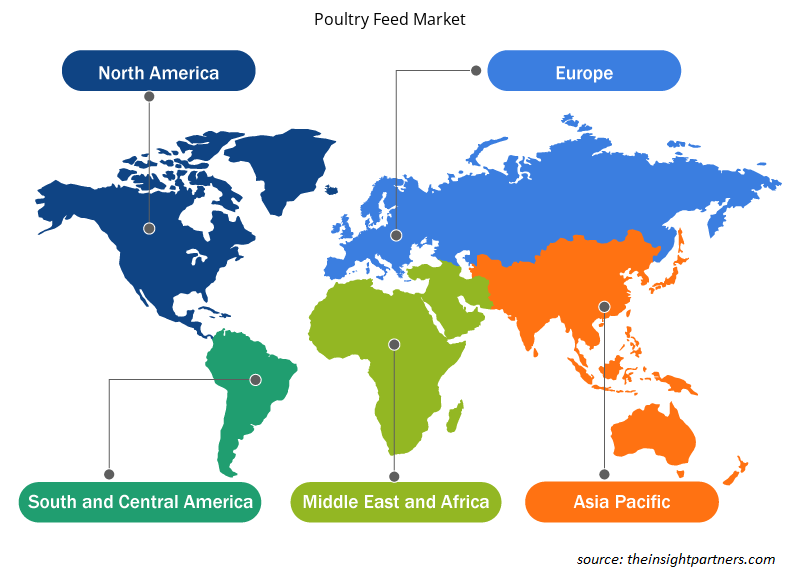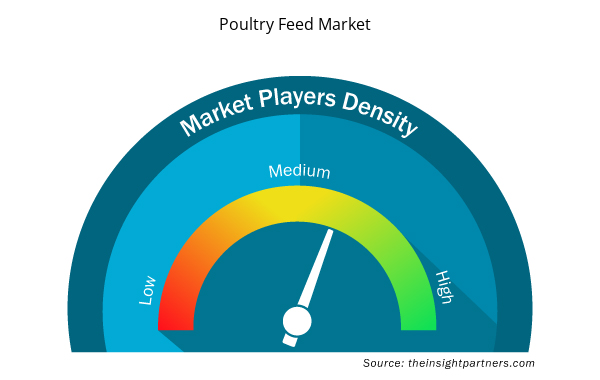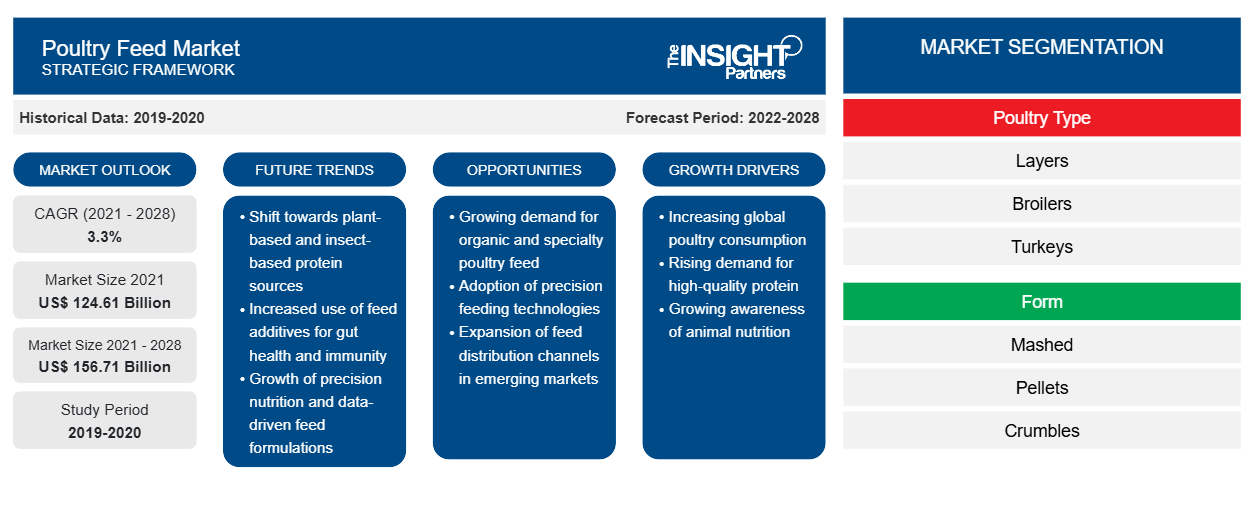2021 年家禽饲料市场价值为 1246.11 亿美元,预计到 2028 年将达到 1567.1 亿美元;预计 2021 年至 2028 年的复合年增长率为 3.3%。
家禽饲料由各种原料制成,例如谷物和谷物、饼或油粕和饲料添加剂。家禽饲料的营养需求取决于家禽的体重和年龄、生长速度和产蛋率。消费者对家禽产品的消费量增加正在推动家禽饲料市场的发展。2020
年,亚太地区占据了全球家禽饲料市场的最大收入份额。亚太地区家禽饲料市场拥有庞大的家禽肉消费人口基数,正呈现显著增长,预计未来几年将继续保持这一势头。中国和印度是全球两个领先的家禽饲料生产国。在印度,家禽饲料生产行业是增长最快的行业之一,饲料制造商之间的竞争日益激烈。该地区的消费者正在寻找额外的富含蛋白质的食物来源。对富含蛋白质的食物的需求增加,加上购买力的增强,极大地刺激了家禽肉的消费。所有这些因素都可能在预测期内推动亚太家禽饲料市场的增长。
定制此报告以满足您的需求
您可以免费定制任何报告,包括本报告的部分内容、国家级分析、Excel 数据包,以及为初创企业和大学提供优惠和折扣
- 获取此报告的关键市场趋势。这个免费样品将包括数据分析,从市场趋势到估计和预测。
COVID-19 疫情对家禽饲料市场的影响
持续的 COVID-19 疫情迫使人们实施预防措施,这极大地改变了动物饲料行业的现状,并对家禽饲料市场的增长产生了负面影响。世界各国政府已下令关闭其国际港口,进一步导致家禽饲料供应链中断。COVID-19 疫情影响了几乎所有国家用于制备家禽饲料的原材料的供应。玉米和大豆是家禽饲料的主要成分。世界上许多依赖进口这些原材料来制备家禽饲料的国家在采购这些原料方面遇到了很大的问题。由于饲料厂关闭,大多数地方都难以获得家禽饲料。全球禽肉消费量急剧下降。全球餐馆关闭严重影响了家禽饲料行业。然而,随着各经济体计划恢复运营,全球对家禽饲料的需求预计将上升。家禽饲料需求的不断增长以及知名制造商的大量投资预计将推动家禽饲料的增长。
市场洞察
家禽产量不断增长
促进家禽饲料市场增长
世界各地的家禽业正在持续增长。家禽被视为最具成本效益的蛋白质来源之一,因此对鸡蛋和肉类等家禽产品的需求持续增长。在更关心健康的人群中,鸡肉消费量激增。家禽产量的上升极大地满足了全球人口日益增长的需求。根据美国粮食及农业组织 (FAO) 的数据,1961 年至 2019 年间,世界禽肉产量从 900 万吨增加到 1.32 亿吨,鸡蛋产量从 1500 万吨增加到 9000 万吨。家禽产量的激增推动了优质家禽饲料产品的使用。
家禽类型洞察
根据家禽类型,全球家禽饲料市场分为蛋鸡、肉鸡、火鸡和其他。 2020 年,肉鸡占据了最大的市场份额。 肉鸡是为肉而饲养的鸡,以高蛋白饮食喂养,以帮助快速生长。 肉鸡饲料有多种形式,例如糊状、颗粒状和碎屑状。 印度是最大的肉鸡生产国之一,肉鸡行业对复合饲料的需求不断增长。 在预测期内,肉鸡产量的增加将继续推动对肉鸡饲料的需求。
表单洞察
根据形式,全球家禽饲料市场分为捣碎饲料、颗粒饲料、碎粒饲料和其他饲料。颗粒饲料在 2020 年占据了最大的市场份额。颗粒饲料是使用蒸汽和压力压缩捣碎饲料制成的。捣碎饲料在制粒机中被压缩并制成坚硬、干燥的颗粒。颗粒饲料通过增加饲料摄入量来提高肉鸡的生长率。这是由于消化率提高、成分分离减少和适口性提高。由于每个颗粒中的成分都混合得很好,颗粒饲料可确保家禽的饮食均衡、饲料转化率更高和性能更好。颗粒饲料的优势,例如饲料易消化、饮食均衡和浪费少,通常导致其需求量大。
全球家禽饲料市场的一些主要参与者是 ADM、嘉吉公司、Alltech、正大食品、For Farmers、Kent Corporation、SHV Holdings、Land O'Lakes、AFGRI Animal Feeds 和 DE HEUS ANIMAL NUTRITION。市场参与者高度专注于开发高质量和创新的产品以满足客户的需求。
家禽饲料市场区域洞察
Insight Partners 的分析师已详细解释了预测期内影响家禽饲料市场的区域趋势和因素。本节还讨论了北美、欧洲、亚太地区、中东和非洲以及南美和中美洲的家禽饲料市场细分和地理位置。

- 获取家禽饲料市场的区域具体数据
家禽饲料市场报告范围
| 报告属性 | 细节 |
|---|---|
| 2021 年市场规模 | 1246.1亿美元 |
| 2028 年市场规模 | 1567.1亿美元 |
| 全球复合年增长率(2021 - 2028) | 3.3% |
| 史料 | 2019-2020 |
| 预测期 | 2022-2028 |
| 涵盖的领域 | 按家禽类型
|
| 覆盖地区和国家 | 北美
|
| 市场领导者和主要公司简介 |
|
市场参与者密度:了解其对商业动态的影响
家禽饲料市场正在快速增长,这得益于终端用户需求的不断增长,而这些需求又源于消费者偏好的不断变化、技术进步以及对产品优势的认识不断提高等因素。随着需求的增加,企业正在扩大其产品范围,进行创新以满足消费者的需求,并利用新兴趋势,从而进一步推动市场增长。
市场参与者密度是指在特定市场或行业内运营的企业或公司的分布情况。它表明相对于给定市场空间的规模或总市场价值,有多少竞争对手(市场参与者)存在于该市场空间中。
在家禽饲料市场运营的主要公司有:
- 腺苷二磷酸
- 嘉吉公司。
- 奥特奇。
- 卜蜂食品有限公司
- 为农民
免责声明:上面列出的公司没有按照任何特定顺序排列。

- 了解家禽饲料市场顶级关键参与者概况
报告亮点
- 家禽饲料市场的渐进式行业趋势可帮助参与者制定有效的长期战略
- 发达市场和发展中市场采用的业务增长战略
- 2019 年至 2028 年家禽饲料市场定量分析
- 全球家禽饲料需求量估计
- 波特五力分析说明了行业内买家和供应商的效力
- 了解竞争市场状况的最新发展
- 市场趋势和前景以及推动和抑制家禽饲料市场增长的因素
- 通过强调支撑商业利益的市场策略来协助决策过程,从而促进市场增长
- 各节点家禽饲料市场规模
- 市场详细概述和细分,以及家禽饲料行业动态
- 各地区家禽饲料市场规模及增长潜力巨大
全球家禽饲料市场
按家禽类型
- 图层
- 肉鸡
- 火鸡
- 其他的
按形式
- 捣碎
- 颗粒
- 碎屑
- 其他的
按类别
- 有机的
- 传统的
公司简介
- 腺苷二磷酸
- 嘉吉公司。
- 奥特奇。
- 卜蜂食品有限公司
- 为农民
- 肯特公司
- SHV 控股
- Land O'Lakes 公司
- AFGRI 动物饲料
- DE HEUS 动物营养
- 历史分析(2 年)、基准年、预测(7 年)及复合年增长率
- PEST 和 SWOT 分析
- 市场规模价值/数量 - 全球、区域、国家
- 行业和竞争格局
- Excel 数据集



Report Coverage
Revenue forecast, Company Analysis, Industry landscape, Growth factors, and Trends

Segment Covered
This text is related
to segments covered.

Regional Scope
North America, Europe, Asia Pacific, Middle East & Africa, South & Central America

Country Scope
This text is related
to country scope.
常见问题
The major players operating in the global poultry feed market are Adm Animal Nutrition, Alltech, Inc., Cargill Inc., Charoen Popkhand Foods, Forfarmers, Hi-Pro Feeds, Inc, Kent Nutrition Group, Inc., Land O’lakes, Inc., Perdue Farms Inc., Southern States Cooperative and many others.
In 2020, the poultry feed market was predominant by Asia Pacific at the global level. With a large base of poultry meat consuming population, the Asia-Pacific poultry feed market is reporting a remarkable growth and is expected to continue to do so over the next few years. China and India are the two leading poultry feed producers in the world. In India, the poultry feed production industry is among the fastest-growing ones with the competition intensifying among feed manufacturers. Consumers in this region are looking for additional sources of protein-rich foods. An increase in demand for protein-rich food, coupled with enhanced purchasing power, has fueled poultry meat consumption extensively. All these factors are likely to fuel the growth of the Asia-Pacific poultry feed market during the forecast period.
Based on form, the global poultry feed market is segmented into pellets, crumbles, mashed, and others. The pellets segment dominated the market during the research period. The pellet feed improves growth rate in broilers with an increased feed intake. This is due to increased digestibility, decreased ingredient segregation, and increased palatability.
The global poultry feed market growth is majorly influenced by determinants such as growing poultry production, rising demand for compound feed in poultry, increasing demand for fortified poultry feed products, and volatility in raw material prices.
By category, the global poultry feed market is bifurcated into organic and conventional. The conventional segment held a larger share in the global poultry feed market in 2020. However, organic segment is expected to register a higher CAGR during the forecast period.
Among the segments of poultry type, broilers segment has led the market in 2020. Broilers are chickens raised for meat and are fed a high-protein diet to help support rapid growth. Broiler chicken feed comes in different forms, such as mash, pellet, and crumble. India is one of the largest broiler producers with the growing demand for compound feed in the broiler industry. The increasing broiler production will continue to boost the demand for broiler poultry feed during the forecast period.
Trends and growth analysis reports related to Food and Beverages : READ MORE..
The list of Companies - Poultry Feed Market
- ADM
- Cargill, Incorporated.
- Alltech.
- Charoen Pokphand Foods PCL
- ForFarmers
- Kent Corporation
- SHV Holdings
- Land O'Lakes, Inc.
- AFGRI Animal Feeds.
- De Heus Animal Nutrition.
The Insight Partners performs research in 4 major stages: Data Collection & Secondary Research, Primary Research, Data Analysis and Data Triangulation & Final Review.
- Data Collection and Secondary Research:
As a market research and consulting firm operating from a decade, we have published and advised several client across the globe. First step for any study will start with an assessment of currently available data and insights from existing reports. Further, historical and current market information is collected from Investor Presentations, Annual Reports, SEC Filings, etc., and other information related to company’s performance and market positioning are gathered from Paid Databases (Factiva, Hoovers, and Reuters) and various other publications available in public domain.
Several associations trade associates, technical forums, institutes, societies and organization are accessed to gain technical as well as market related insights through their publications such as research papers, blogs and press releases related to the studies are referred to get cues about the market. Further, white papers, journals, magazines, and other news articles published in last 3 years are scrutinized and analyzed to understand the current market trends.
- Primary Research:
The primarily interview analysis comprise of data obtained from industry participants interview and answers to survey questions gathered by in-house primary team.
For primary research, interviews are conducted with industry experts/CEOs/Marketing Managers/VPs/Subject Matter Experts from both demand and supply side to get a 360-degree view of the market. The primary team conducts several interviews based on the complexity of the markets to understand the various market trends and dynamics which makes research more credible and precise.
A typical research interview fulfils the following functions:
- Provides first-hand information on the market size, market trends, growth trends, competitive landscape, and outlook
- Validates and strengthens in-house secondary research findings
- Develops the analysis team’s expertise and market understanding
Primary research involves email interactions and telephone interviews for each market, category, segment, and sub-segment across geographies. The participants who typically take part in such a process include, but are not limited to:
- Industry participants: VPs, business development managers, market intelligence managers and national sales managers
- Outside experts: Valuation experts, research analysts and key opinion leaders specializing in the electronics and semiconductor industry.
Below is the breakup of our primary respondents by company, designation, and region:

Once we receive the confirmation from primary research sources or primary respondents, we finalize the base year market estimation and forecast the data as per the macroeconomic and microeconomic factors assessed during data collection.
- Data Analysis:
Once data is validated through both secondary as well as primary respondents, we finalize the market estimations by hypothesis formulation and factor analysis at regional and country level.
- Macro-Economic Factor Analysis:
We analyse macroeconomic indicators such the gross domestic product (GDP), increase in the demand for goods and services across industries, technological advancement, regional economic growth, governmental policies, the influence of COVID-19, PEST analysis, and other aspects. This analysis aids in setting benchmarks for various nations/regions and approximating market splits. Additionally, the general trend of the aforementioned components aid in determining the market's development possibilities.
- Country Level Data:
Various factors that are especially aligned to the country are taken into account to determine the market size for a certain area and country, including the presence of vendors, such as headquarters and offices, the country's GDP, demand patterns, and industry growth. To comprehend the market dynamics for the nation, a number of growth variables, inhibitors, application areas, and current market trends are researched. The aforementioned elements aid in determining the country's overall market's growth potential.
- Company Profile:
The “Table of Contents” is formulated by listing and analyzing more than 25 - 30 companies operating in the market ecosystem across geographies. However, we profile only 10 companies as a standard practice in our syndicate reports. These 10 companies comprise leading, emerging, and regional players. Nonetheless, our analysis is not restricted to the 10 listed companies, we also analyze other companies present in the market to develop a holistic view and understand the prevailing trends. The “Company Profiles” section in the report covers key facts, business description, products & services, financial information, SWOT analysis, and key developments. The financial information presented is extracted from the annual reports and official documents of the publicly listed companies. Upon collecting the information for the sections of respective companies, we verify them via various primary sources and then compile the data in respective company profiles. The company level information helps us in deriving the base number as well as in forecasting the market size.
- Developing Base Number:
Aggregation of sales statistics (2020-2022) and macro-economic factor, and other secondary and primary research insights are utilized to arrive at base number and related market shares for 2022. The data gaps are identified in this step and relevant market data is analyzed, collected from paid primary interviews or databases. On finalizing the base year market size, forecasts are developed on the basis of macro-economic, industry and market growth factors and company level analysis.
- Data Triangulation and Final Review:
The market findings and base year market size calculations are validated from supply as well as demand side. Demand side validations are based on macro-economic factor analysis and benchmarks for respective regions and countries. In case of supply side validations, revenues of major companies are estimated (in case not available) based on industry benchmark, approximate number of employees, product portfolio, and primary interviews revenues are gathered. Further revenue from target product/service segment is assessed to avoid overshooting of market statistics. In case of heavy deviations between supply and demand side values, all thes steps are repeated to achieve synchronization.
We follow an iterative model, wherein we share our research findings with Subject Matter Experts (SME’s) and Key Opinion Leaders (KOLs) until consensus view of the market is not formulated – this model negates any drastic deviation in the opinions of experts. Only validated and universally acceptable research findings are quoted in our reports.
We have important check points that we use to validate our research findings – which we call – data triangulation, where we validate the information, we generate from secondary sources with primary interviews and then we re-validate with our internal data bases and Subject matter experts. This comprehensive model enables us to deliver high quality, reliable data in shortest possible time.


 获取此报告的免费样本
获取此报告的免费样本